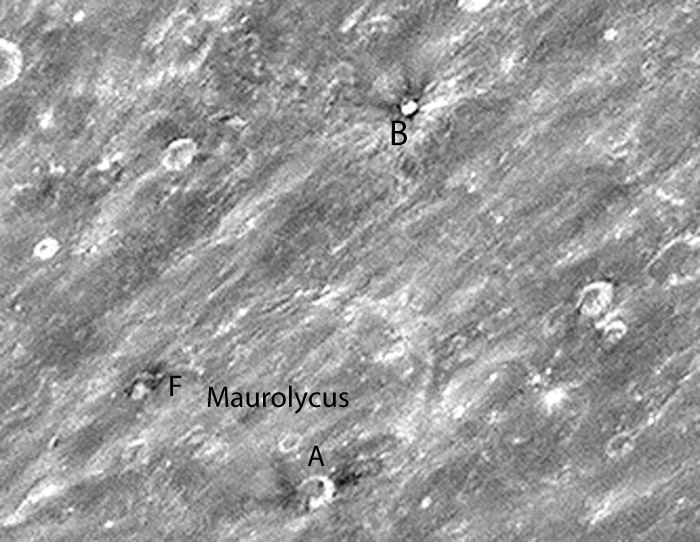April 7, 2010
More Highland Plutons

image by Yuri Goryachko, Mikhail Abgarian, Konstantin Morozov, Minsk, Belarus
While looking at a beautiful full Moon mosaic by Yuri & the Astronominsk team I noticed a number of very dark spots in the southern highlands. One is a familiar oddity - Buch B, a dark halo crater that excavated not mare basalts but a pluton of similar magma. What is a pluton? It is a mass of igneous rock that rose up from the mantle but didn't reach the surface to erupt. This excerpt from the mosaic - which I have made twice its normal size and greatly contrast stretched - shows two similar dark deposits near Maurolycus. One is the crater Maurolycus A and the other is a small unlettered crater near Maurolycus F. Both of these halos also appear to be ejecta from the impacts, suggesting that there are additional basaltic plutons in this area. A real question is why didn't other craters nearby also excavate dark material? Perhaps the plutons are like narrow fingers of rising magma. But why are they here anyway? Almost all mare deposits on the Moon are in basins which have deep fractures that provide conduits from the mantle to the surface. What makes the conduits in the highlands? Ancient, undetected basins, or is a large crater like Maurolycus adequate? Of course, Buch B is not on a large crater so what allowed the pluton there to reach nearly to the surface? Look carefully over the entire mosaic to find other dark highland mysteries.
Chuck Wood
Technical Details
March 29, 2010 21:20UT. Maksutov-Cassegrain Santel D=230mm F=3000mm + Unibrain Fire-i 702 CCD b/w camera (IEEE-1394, 1388x1040) + Baader IR-pass filter. Processing in Registax & Avistack. Deconvolution in Maxim DL.
Related Links
Rükl plate 66
Minsk Miracle Workers website
Yesterday's LPOD: Flat Out of Luck
Tomorrow's LPOD: Textured Ejecta
COMMENTS?
Register, Log in, and join in the comments.



